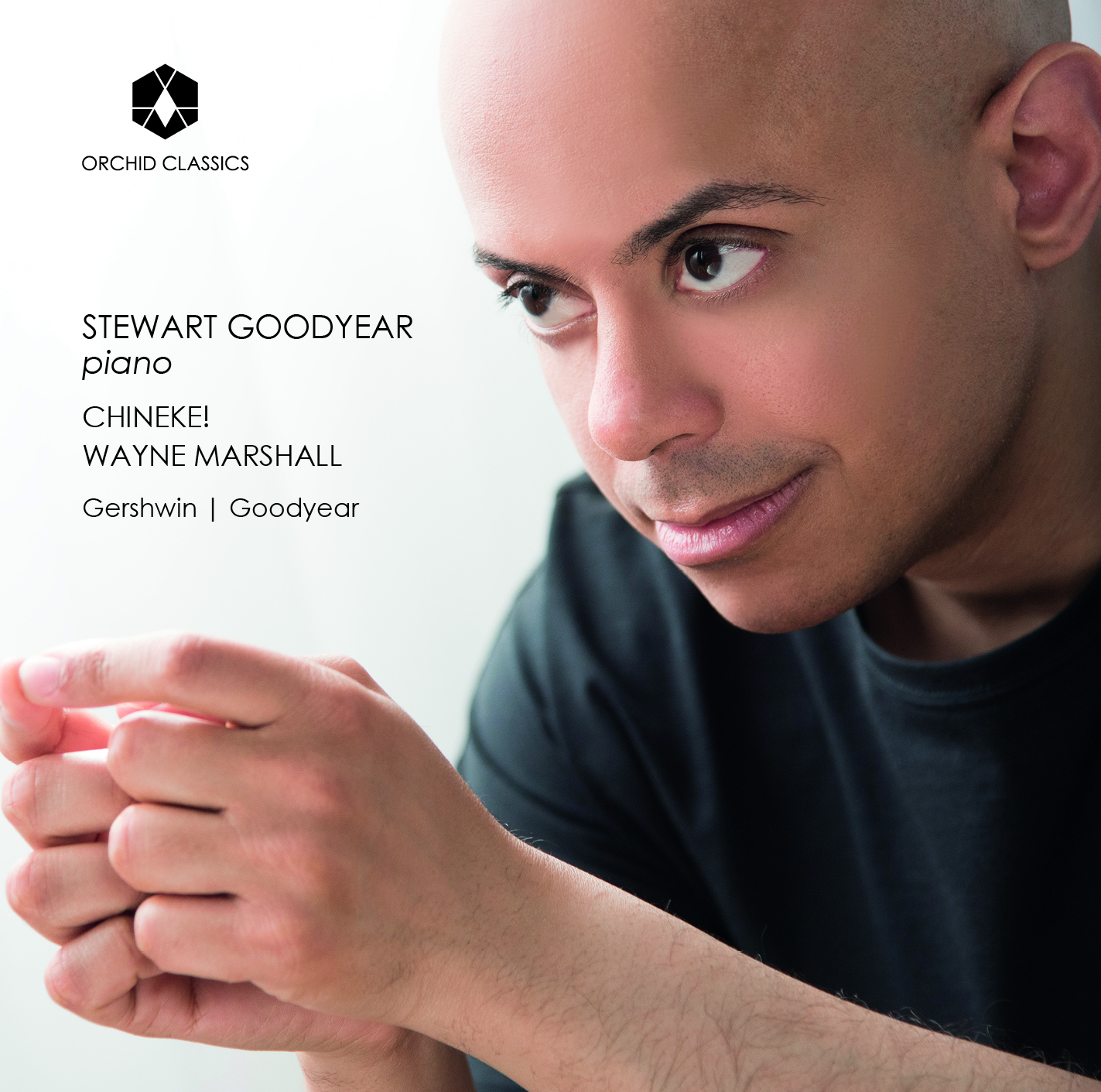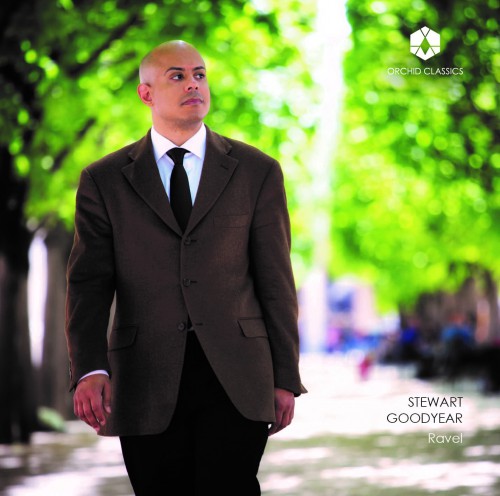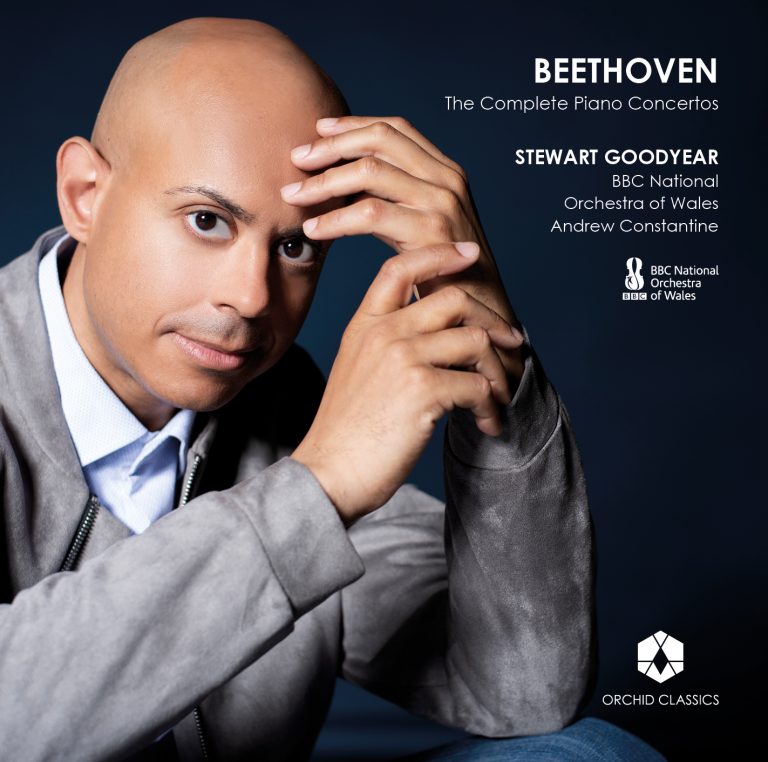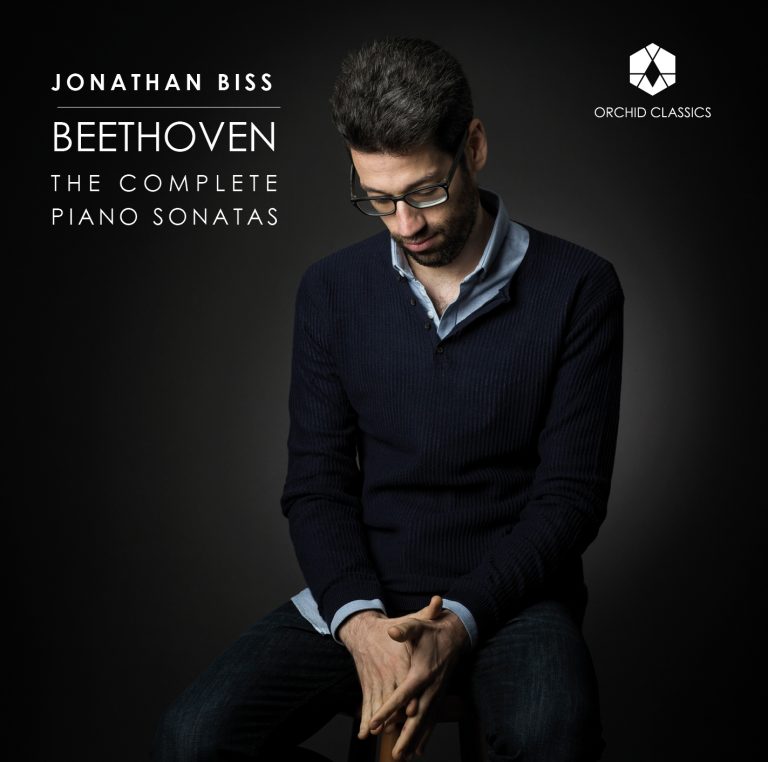Artist Led, Creatively Driven

Stewart Goodyear, piano
Chineke! Orchestra
Wayne Marshall, conductor
Release Date: June 7th 2019
ORC100100
STEWART GOODYEAR piano
CHINEKE!
WAYNE MARSHALL
Gershwin | Goodyear
Stewart Goodyear (b.1978)
Callaloo*
1. I Panorama 6.08
2. II Mento 4.37
3. III Ballad 5.53
4. IV Piano Solo 3.20
5. V Soca 7.12
Stewart Goodyear
Piano Sonata*
6. I 6.35
7. II 4.11
8. III 6.14
George Gershwin (1898-1937)
9. Rhapsody in Blue 16.13
Original jazz band version
Total Time 60.26
Stewart Goodyear, piano
Wayne Marshall, conductor
Chineke! Orchestra
*World premiere recording
One might say that Callaloo is my soul food…a dish from the Caribbean composed of spices from different cultures, deliciously blended together. I grew up in a city where the population was what one would call a “callaloo”, composed of people of various backgrounds and religions blending together to create an authentic urban flavour. The people of Trinidad, where half my family is from, call their community a “callaloo” nation, and they celebrate their history and present every February with Carnival, a festival of different sounds and traditions. Calypso, a blend of jazz, African and French influences, is the heart of Trinidad.
My Suite for piano and orchestra, aptly enough titled Callaloo, was composed in 2016, two years after my first Carnival in Trinidad. At that festival, I was exposed to gorgeous Calypso music for two weeks straight, riveted every second. The instrumentation of the suite is almost identical to the symphony orchestra version of Gershwin’s Rhapsody in Blue, with bongos taking the place of the banjo.
The first movement, Panorama, is a high-spirited medley of three different melodic and rhythmic ideas. At Carnival, Panorama is a competition between different steel pan groups, each one giving their best arrangements and medleys of the top three Calypso songs of the year. The most successful medley wins the prize. For this movement, I wrote my own three themes, but bringing elements that would be familiar to Calypso lovers. The movement uses all the instruments except the horns.
The second movement, Mento, is a mid-tempo homage to the Jamaican folk song, with a middle section in 3/4 time inspired by Afro-Cuban music. This movement uses only solo piano, horns and strings.
The third movement, Ballad, is a slow-tempo mento, made famous in the Western world by artists like Harry Belafonte. This movement uses solo piano, the lower strings, flutes, clarinets and bassoons, and the percussion section. The atmosphere is that of a siesta, and the colour is that of a golden sunset.
The fourth movement is a cadenza for solo piano, starting calm and gradually building up to a frenzy before the last movement, Soca.
Soca, the huge finale of Carnival, is inspired by the Mas, a parade of soca bands and DJs with the costumed participants dancing in the streets to the music played. Everyone comes out to see and participate in the Mas, so it was only appropriate for me to use all the orchestral forces! If you listen closely, there is also a “sampling” of my piano sonata in this movement.
The world premiere of this work, with Kristjan Jarvi conducting the MDR Symphony Orchestra, was in Leipzig, a city that I learned has an underground fan base of Calypso! The response from the audience was electrifying….They cheered and whooped, whistled and stamped. It was the response I hoped and composed for!
My Piano Sonata, composed when I was 18, was premiered at my graduation piano recital at the Curtis Institute of Music. As Callaloo was composed in response to my first Carnival, the Piano Sonata was inspired by my high school prom and the music of my age group. As this was a teenage work, my youthful exuberance also wanted to pull out all the stops and create the most difficult piano work ever composed. This sonata is therefore a combination of piano virtuosity, teenage hubris, and the popular music I heard in 1997.
The first movement, sonata-allegro, combines tonality and atonality, 12-tone techniques and techno music.
The slow second movement is another ballad, this time inspired by the smooth pop music I heard while slow-dancing with my date.
The third movement, Rondo, is a celebration of Toronto, and incorporates rock, Canadian folk song, Indian singing, and Latin infused music.
The album ends with the inspiration for my Caribbean suite, and the work that I discussed earlier: George Gershwin’s Rhapsody in Blue. As I wanted to create a bridge between classical and Calypso with Callaloo, Gershwin created a bridge between classical and jazz with Rhapsody in Blue. I would describe Gershwin’s Rhapsody as a callaloo, as it incorporates not only pop music from the 1970s, but pays homage to the composer’s ethnic background and the multicultural community of the composer’s city. One hears the klezmer howl of the clarinet which opens the piece, giving way to a blues melody which is the heart of the rhapsody. A seamless merging of two musical traditions creating the soundtrack of New York. The combination of romantic and modern, and symphonic and popular, created a revolution unrivalled in music history. The audience members were dancers of the Charleston in clubs and listeners of symphonies in concert halls. The wall separating them was successfully broken.
This recording would not be possible without the love, support, care and musicianship of Wayne Marshall, Chi-chi Nwanoku, and all the members of Chineke! Orchestra. This collaboration is one that I will always treasure. Thank you all from the bottom of my heart!
© Stewart Goodyear
Stewart Goodyear
Proclaimed “a phenomenon” by the Los Angeles Times and “one of the best pianists of his generation” by the Philadelphia Inquirer, Stewart Goodyear is an accomplished young pianist as a concerto soloist, chamber musician, recitalist and composer. Mr. Goodyear has performed with major orchestras of the world , including the Philadelphia Orchestra, New York Philharmonic, Chicago Symphony, Pittsburgh Symphony, San Francisco Symphony, Los Angeles Philharmonic, Cleveland Orchestra, Academy of St Martin in the Fields, Bournemouth Symphony, Frankfurt Radio Symphony, MDR Symphony Orchestra (Leipzig), Montreal Symphony, Toronto Symphony Orchestra, Dallas Symphony , Atlanta Symphony, Baltimore Symphony, Detroit Symphony, Seattle Symphony, Mostly Mozart Festival Orchestra, Royal Liverpool Philharmonic, and NHK Symphony Orchestra.
Mr. Goodyear began his training at The Royal Conservatory in Toronto, received his bachelor’s degree from Curtis Institute of Music, and completed his master’s at The Juilliard School. Known as an improviser and composer, he has been commissioned by orchestras and chamber music organizations, and performs his own solo works. Last year, Mr. Goodyear premiered his suite for piano and orchestra, “Callaloo”, with Kristjan Jarvi and MDR Symphony Orchestra in Leipzig, and last summer, the Clarosa Quartet premiered his Piano Quartet commissioned by the Kingston Chamber Music Festival. Mr. Goodyear performed all 32 Beethoven Piano Sonatas in one day at Koerner Hall, McCarter Theatre, the Mondavi Center, and the AT&T Performing Arts Center in Dallas.
Mr. Goodyear’s discography includes Beethoven’s Complete Piano Sonatas (which received a Juno nomination for Best Classical Solo Recording in 2014) and Diabelli Variations for the Marquis Classics label, Tchaikovsky’s First Piano Concerto and Grieg’s Piano Concerto, and Rachmaninov’s Piano Concertos No. 2 and 3, both recorded with the Czech National Symphony under Stanislav Bogunia and Hans Matthias Forster respectively, and released to critical acclaim on the Steinway and Sons label. His Rachmaninov recording received a Juno nomination for Best Classical Album for Soloist and Large Ensemble Accompaniment. Also for Steinway and Sons is Mr. Goodyear’s recording of his own transcription of Tchaikovsky’s “The Nutcracker (Complete Ballet)”, which was released October 2015 and was chosen by the New York Times as one of the best classical music recordings of 2015. Mr. Goodyear’s recording of Ravel’s piano works was released on the Orchid Classics label in the spring of 2017, and his new recording “For Glenn Gould”, that combines repertoire performed by Gould in his US and Montreal debuts, was released March 2018.
Highlights of the 2018-10 season have been a UK tour with Chineke!, return engagements with the Philadelphia Orchestra, Toronto, Vancouver and Victoria Symphony orchestras, and three recitals for the Chamber Music Society of Detroit. His new concerto, “Ur-”, was commissioned by The Royal Conservatory of Music in Toronto, and premiered by the Toronto Symphony January 2019. Mr. Goodyear’s Cello Concerto, commissioned by the National Arts Centre Orchestra in Ottawa, will be premiered in the 2019-20 season.
Wayne Marshall
British conductor, organist and pianist Wayne Marshall is Chief Conductor of WDR Funkhausorchester Cologne, and Organist and Associate Artist of the Bridgewater Hall. He became Principal Guest Conductor of Orchestra Sinfonica di Milano Giuseppe Verdi in 2007. Marshall is a celebrated and award-winning interpreter of Gershwin, Bernstein and other 20th century American composers. He has recorded extensively for numerous major labels and received an ECHO Award for his Gershwin Songbook recording. His latest organ recording released on Fugue State Records, Gershwin and Bernstein Improvised,has received numerous excellent reviews. In 2004 he received an Honorary Doctorate from Bournemouth University and in 2010 he became a Fellow of the Royal College of Music. In October 2016 Marshall was awarded the Independence Golden Jubilee Award towards his contribution for outstanding service to the UK. In May 2018 Wayne was appointed Ambassador of the London Music Fund.
He made his debut at Montreal Opera by conducting Jake Heggie’s acclaimed opera Dead Man Walking and this was immediately followed by a return-invitation to conduct Gershwin’s Porgy and Bess. He also conducted Bernstein’s Candide and Kurt Weill’s Mahagonny at the Deutsche Staatsoper in Berlin. At the Opera Comique in Paris, Washington Opera and Dallas Opera he conducted Gershwin’s Porgy and Bess
and at the Semperoper in Dresden he conducted The Great Gatsby by John Harbison.
In 2018 Wayne recorded a Gershwin CD with WDR Funkhaus Orchestra in Cologne and a double-CD featuring all of Bernstein’s lesser-known chamber music works.
In 2019 Wayne Marshall returns to Rotterdam Philharmonic Orchestra for their New Year’s Concert celebration. He will be working with various orchestras including Prague Radio Philharmonic, the Dresden Philharmonic, SWR in a Frank Zappa project, Tonkuenstler Orchestra at the Musikverein and Graffengg, Seattle Symphony Orchestra, Shanghai Philharmonic, Czech Philharmonic, and will also be touring with Chineke! in the United Kingdom. In October 2019 he will be opening the season and touring in the Netherlands with Het Gelders Orkest and ReisZuid-Nederland in a fully-staged production of Bernstein’sWonderful Town.
In 2020 Wayne Marshall has been invited to conduct Gershwin’s Porgy and Bess at the Wiener Staatstoper with the Cape Town Opera Chorus.
Some past highlights include conducting at La Scala, Teatro Carlo Fenice, Washington Opera, Czech Philharmonic and Oslo Philharmonic Orchestras. He was the first conductor to direct the highly-acclaimed debut concert of Chineke! – Europe’s first professional black and ethnic minority orchestra – at the Queen Elizabeth Hall in London. Wayne Marshall has been invited to conduct the Royal Scottish National Orchestra, Taipei Symphony, Leipzig Gewandhaus, Vienna Symphony, New World Symphony Orchestra, Orchestre National du Capitole de Toulouse, Malaysian Philharmonic, Luxembourg Philharmonic, Santa Cecilia, Royal Stockholm Philharmonic, RAI Turin, BBC Philharmonic, Hong Kong Philharmonic, Dresden Philharmonic, and Moscow Chamber Choir.
Chineke! Orchestra
The Chineke! Foundation was established in 2015 to provide career opportunities for young Black and Minority Ethnic (BME) classical musicians in the UK and Europe. Chineke!’s mission is: ‘Championing change and celebrating diversity in classical music’. The organisation aims to be a catalyst for change, realising existing diversity targets within the industry by increasing the representation of BME musicians in British and European orchestras.
The Foundation’s flagship ensemble, the Chineke! Orchestra, comprises exceptional musicians from across the continent brought together several times a year. As Europe’s first majority-BME orchestra, Chineke! performs standard orchestral repertoire along with the works of BME composers both past and present.
The Chineke! Orchestra works closely with its sister ensemble, the Chineke! Junior Orchestra, a youth orchestra of BME players aged between 11 and 22, with senior players acting as mentors, teachers and role models to the young musicians. Many of our junior musicians already benefit from existing youth schemes, junior music colleges and specialist music schools across the UK. The Chineke! Junior Orchestra acts as a bridge between such schemes and higher education, giving its players experience, encouragement and confidence, with the hope of increasing the numbers of BME candidates currently studying music at third level. This process has already begun, with several of the junior musicians having won national competitions, gained places at top music schools or been admitted to elite conservatoires and institutions.
Chineke! is the brainchild of Chi-chi Nwanoku OBE, who says: ‘My aim is to create a space where BME musicians can walk on stage and know that they belong, in every sense of the word. If even one BME child feels that their colour is getting in the way of their musical ambitions, then I hope to inspire them, give them a platform, and show them that music, of whatever kind, is for all people.’
Many cultural organisations such as the BBC, Association of British Orchestras, Royal Philharmonic Society and Arts Council England agree with this sentiment, and have supported Chineke!. After its launch concert at Queen Elizabeth Hall in September 2015, the Chineke! Orchestra was appointed as an Associate Orchestra of Southbank Centre, and has performed there and in other major venues across the UK and Europe.
Chineke! has been covered extensively by national and international press and broadcast media, and the Foundation’s work is featured prominently in the Government’s Department of Culture, Media and Sport’s White Paper on Culture published in 2016. The orchestra was shortlisted for RPS Awards in both 2016 and 2017. In 2017, the orchestra released its first album and made its BBC Proms debut at the Royal Albert Hall in August, to much critical acclaim. In 2018, the orchestra gave the inaugural concert at the newly refurbished Queen Elizabeth Hall and performed there again in July as part of the Southbank Centre’s Africa Utopia festival. The summer of
2018 also saw the release of Chineke!’s second album, with two more due in 2019.
The aims of the Chineke! Foundation and Orchestra are certainly ambitious. In the words of Sir Simon Rattle: ‘Chineke! is not only an exciting idea but a profoundly necessary one. The kind of idea which is so obvious that you
wonder why it is not already in place. The kind of idea which could deepen and enrich classical music in the UK for generations. What a thrilling prospect!’









